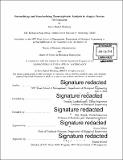| dc.contributor.advisor | Douglas Lauffenburger and Roy Welsch. | en_US |
| dc.contributor.author | Weinberg, Kerry Rachel | en_US |
| dc.contributor.other | Leaders for Global Operations Program. | en_US |
| dc.date.accessioned | 2016-09-13T19:24:35Z | |
| dc.date.available | 2016-09-13T19:24:35Z | |
| dc.date.copyright | 2016 | en_US |
| dc.date.issued | 2016 | en_US |
| dc.identifier.uri | http://hdl.handle.net/1721.1/104314 | |
| dc.description | Thesis: M.B.A., Massachusetts Institute of Technology, Sloan School of Management, 2016. In conjunction with the Leaders for Global Operations Program at MIT. | en_US |
| dc.description | Thesis: S.M. in Engineering Systems, Massachusetts Institute of Technology, Department of Biological Engineering, 2016. In conjunction with the Leaders for Global Operations Program at MIT. | en_US |
| dc.description | Cataloged from PDF version of thesis. | en_US |
| dc.description | Includes bibliographical references (pages 71-75). | en_US |
| dc.description.abstract | Building biological understanding of the Chinese Hamster Ovary (CHO) system used to manufacture therapeutic proteins is paramount to efficient CHO bioprocess optimization. This understanding can be built by analyzing and synthesizing biological data; such as transcriptomic (gene expression), proteomic (protein levels), or metabolomic (metabolite levels). This thesis describes a streamlined workflow for analyzing transcriptomic data. This streamlined workflow not only reduced the barrier to conducting the analysis but also reduced the analysis cycle time. With the use of this workflow, a number of historical Amgen microarray datasets were mined to identify gene expression signatures indicative of productivity. The result of this mining identified key biological pathways specific to a highly productive Amgen cell line. This work suggests that these pathways are critical to heightened levels of protein production. Using this information to engineer future cell lines could enable Amgen to improve cellular protein production by over 30%, impacting costs associated with drug substance manufacturing. More broadly, this example of streamlining and standardizing transcriptomic data provides a framework for how Amgen Process Development can leverage biological data to improve CHO systems understanding and achieve operational impacts. | en_US |
| dc.description.statementofresponsibility | by Kerry Rachel Weinberg. | en_US |
| dc.format.extent | 75 pages | en_US |
| dc.language.iso | eng | en_US |
| dc.publisher | Massachusetts Institute of Technology | en_US |
| dc.rights | MIT theses may be protected by copyright. Please reuse MIT thesis content according to the MIT Libraries Permissions Policy, which is available through the URL provided. | en_US |
| dc.rights.uri | http://dspace.mit.edu/handle/1721.1/7582 | en_US |
| dc.subject | Sloan School of Management. | en_US |
| dc.subject | Biological Engineering. | en_US |
| dc.subject | Leaders for Global Operations Program. | en_US |
| dc.title | Streamlining and standardizing transcriptomic analysis in Amgen process development | en_US |
| dc.type | Thesis | en_US |
| dc.description.degree | M.B.A. | en_US |
| dc.description.degree | S.M. in Engineering Systems | en_US |
| dc.contributor.department | Leaders for Global Operations Program at MIT | en_US |
| dc.contributor.department | Massachusetts Institute of Technology. Department of Biological Engineering | |
| dc.contributor.department | Sloan School of Management | |
| dc.identifier.oclc | 958279112 | en_US |
